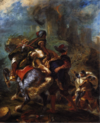Romanticism Flashcards
Romanticism
- both Romanticism and Neoclassicism are occupied with the look of daily reality
- 19th century Neoclassical style becomes overblown
started as a protest against the Rococo tastes if the 18th century aristocrats
turned into an official ‘heroic’ art that glorified first Napoleon, then a succession of lesser aristocrats throughout Europe
France: Académie des Beaux virtually dictated the tastes that artists could employ
England: Royal Academy of Fine Arts hew to traditions by copying plaster busts of ancient Roman emperors and scaled-down versions of the Lacoön
As Neoclassicism had been a reaction against the florid, overdramatic Baroque style and the vapid Rococo, Romanticism was a revolt against the rational qualities of the Neoclassical
Neoclassicism vs Romanticism

Inspirations for Romanticism
-As gathering forces of dissent in France, Germany, and England; Romanticism set in
Literary interest in Medieval tales, known as romances, inspired this new art
Inspirations:
heroic literature of Lord Byron, Sir Walter Scott, and Victor Hugo
vigor of the new industrial age
high drama of nature at its most elemental—storms at sea, Alpine landslides
allure of foreign lands and locales
-architecture: first found fulfillment in use of ‘Gothic elements
lordly estates sprouted crenelated towers and thick walls pierced by narrow windows
Horace Walpole’s home near London
Reconstruction of the Houses of Parliament, London, after the fire

France:
-Eugene Delacroix
Master colorist with notable flare for exotic
Romantic credo: belief in the nobility of ancient peoples
Detected in Arabs of North Africa during his own time, versus the inhabitants of classical Greece
Concerned less with literal rendition than with conveying drama and emotion
Filled his works with bright color and energetic movement
The Abduction of Rebecca, 1846
depicts a key moment in Sir Walter Scott’s novel Ivanhoe, in which the heroine is carried off by the villain

England:
-Joseph Mallord William Turner
Landscapist
Centered paintings on beauties and terrors of nature
Snowstorm
Study of the raw fury of the sea as it threatens to overwhelm a steamship in the center which is dimly perceived
Painted after personally experiencing it
Strikingly abstract
Demonstrates his obsession with color and light and dynamic movement, often at the expense of form and realistic rendering

-John Constable
Landscapist
Nature’s serene side
Scrutiny of his components—the green of vegetation, shimmer of placid water, puffy insubstantiality of clouds
Clarity of his colors, derived from his close observation of nature, impacted painters in France
Delacroix retouched one of his own canvases after seeing Constable’s landscapes in Paris
The Lock, Dedham, 1824
“Painting is with me but another word for feeling”
calm vistas and glowing tones
End of Romanticism
Romanticism lost its sway toward mid-century
- political and social unrest in Europe inspired a revolutionary new view of the function of art
- Charles Baudelaire
French poet and art critic
Painting should express “the heroism of modern life”
Most Neoclassical and Romantic painters focused on the past—few focused on the look of daily reality

